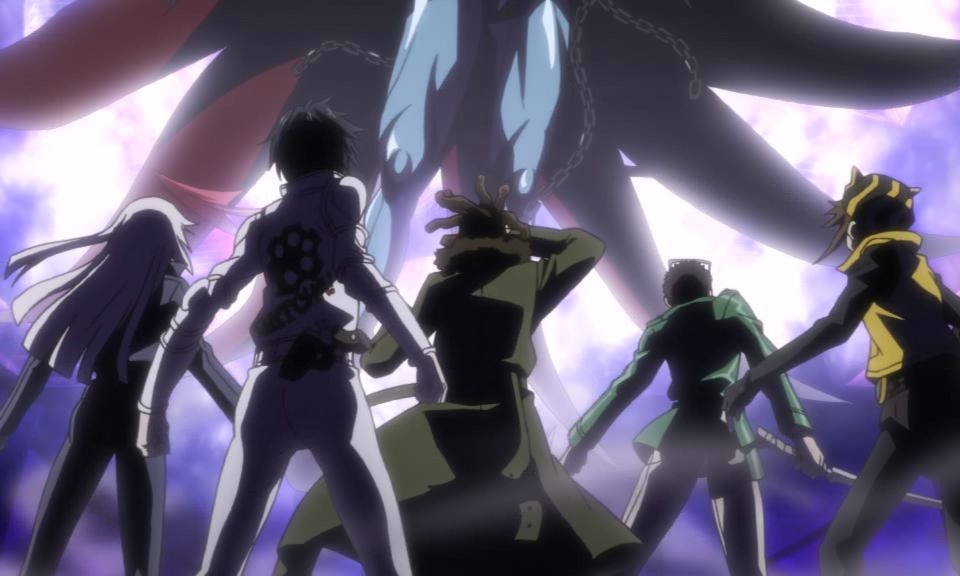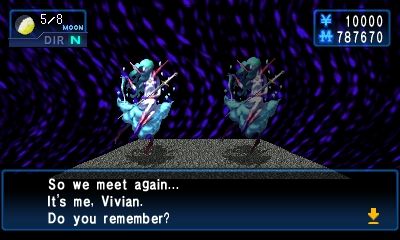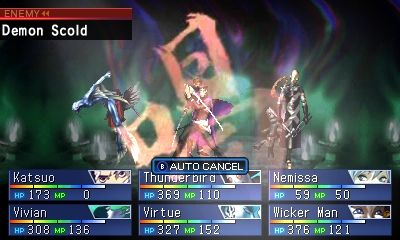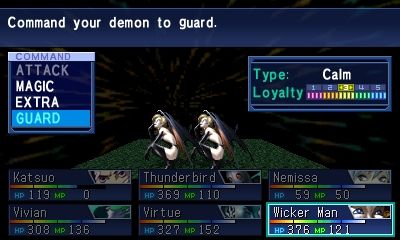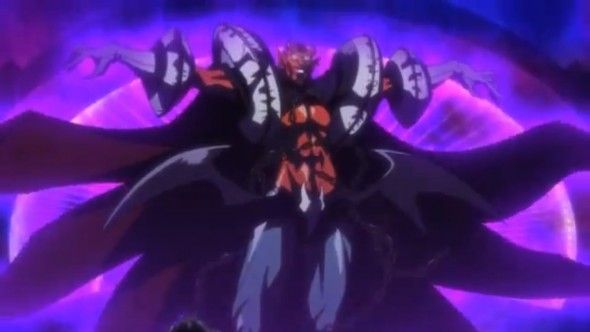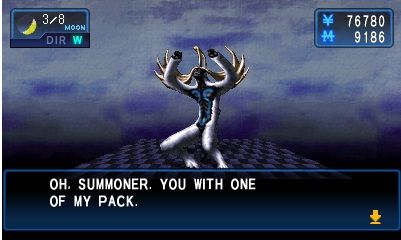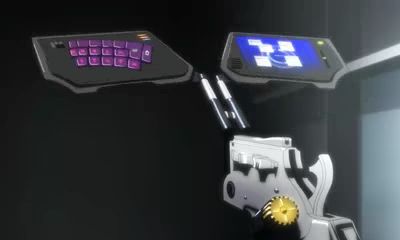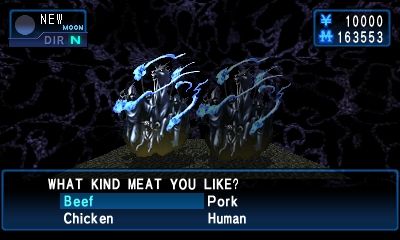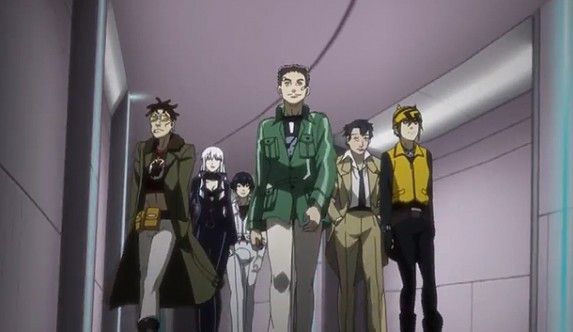Shin Megami Tensei: Devil Summoner: Soul Hackers is a remake of a game that originally released for the Sega Saturn in Japan way back in 1997. With the following the series has since amassed outside of Japan, it only makes sense that the rest of the world get a fair shot at this obscure title. Soul Hackers makes its North American debut as a full on enhanced remake of the original game, but has Atlus provided quite enough polish to make the 16 year old title feel fresh?
Although it obviously looks much better than the original Sega Saturn game, Soul Hackers doesn't look particularly good. Enemy sprites are gritty and poorly detailed, though colorful. Environments – which are 3D and explored from a first person perspective – are similarly grainy, although detailed enough to serve their purpose. The character portraits are the sharpest visual component in the game, and they look clean and polished. The navigational menus and maps look somewhat old, but they’re clean enough to be functional.
An interesting thing bout the game's visuals is that the original CG cutscenes are intact. They look pretty old and are graphically unimpressive, but they're kind of charming.
Some things in Soul Hackers are downright ugly. For example, the character sprites that appear during the dialogue scenes look a horrible. Also, there’s very little use (if any at all) of the console’s 3D capability. The game looks and feels noticeably dated, and this is apparent in not just the visuals but in other aspects of the title as well. Visuals aren’t especially important in this kind of game, but the age of the core game is readily apparent here.
Instead of feeling dated, the music in the game feels retro and refreshing. The soundtrack maintains a throwback charm and I found it quite pleasant most of the time. Even though I never played the original game, the soundtrack somehow brought me feelings of nostalgia. It sounds comparable to an early 90s crime drama show or something. The dialogue in the game is voiced, and I didn't think any of the voices where especially good or terrible.
I thought the game’s story was interesting if not thoroughly compelling. You take control of a young student who’s a member of Team Spooky – a group of hackers who solves mysteries and stuff. After a series of events involving body jumping or “vision quests”, you earn a COMP or GUMP (a gun type PC) which allows you to summon demons. The general story focuses on a shadowy organization known as Phantom and their motives for creating a realistic virtual world known as Paradigm X. There are a number of factions and goings on with demons, spirits and the like.
The game isn’t quite as dialogue heavy as some of the Persona games, but there is still a good amount of character development. Unlike the original game, most of the dialogue between characters is voiced, which is appreciated. You’ll probably want to finish the game to see how things play out, but I’d played for a very long time before I actually cared what happened next.
Although it has many interesting game-play components, some of the game feels pretty dated. This is due more to a combination of factors than to any single factor. Initially, the game feels somewhat difficult, but once you have your bearings after the first few hours it becomes a lot more enjoyable. You adventure and explore environments from a first person perspective. Battles occur randomly and not too frequently, although you can increase or decrease the frequency of battles through the use of certain items in the game.
In battle you bring your two player controlled characters and up to four demons. The most common way to obtain a demon is by talking to it during combat. One of the options in combat is to talk to your enemies, but I found that most of the time the demons would rather fight me than join me. This can prove to be a bit irritating in the beginning because you need to build a considerable arsenal of demons so that you can fuse them into stronger demons. Getting them to join you feels kind of like Pokemon, only much less straightforward.
Different kinds of demons respond to different things. For example, one demon may join you if you say something tough or mean to it. Other demons will only join if you give them a certain item. Sometimes I wished I could just beat them down and catch them in a Pokéball, but you will unfortunately have to go through the motions of trial and error in order to get them to join you most of the time. Sometimes it seems best if you simply choose a random response.
I think getting to know the different demons and figuring out how to get them to join you is supposed to be fun, but I found it rather worrisome.
The demons have their own wills and this can make them feel less like they belong to the player and more like independent party members that just do random things as they please, sometime causing more damage to the party rather than helping. You aren't through suffering after you actually get a demon to join. At this point, you have to contend with the demon’s loyalty and personality. The demon’s loyalty measures how loyal it is to you, the summoner. If it’s loyal to you then it will trust your judgment and actually follow your orders in combat.
If it isn't loyal to you, then it will disobey your commands and make combat a truly grueling experience. When a demon disobeys your order to heal the party and instead kills itself to deal minimal damage to the enemy, the game starts to feel artificially difficult. If a demon disobeys several of your orders, then in some time it will actually just leave and abandon the party. A demon’s personality determines which kinds of commands it will follow. A demon that is kind will always obey a command to heal or guard, but they will rarely follow a command to attack unless they’re very loyal to you.
As if all of these stipulations weren't enough, you also have to concern yourself with a demon’s alignment. Every demon is closer to a light, dark or neutral alignment. The overall alignment of your party determines which kind of demons you can summon. For example, if you have mostly light demons in your party, then you won’t be able to summon a dark demon.
In a way the demons are similar to Pokemon, but they are far more complex and require much more happiness before they’ll just do as you say. If you find it fun to contend with and fight the demons into true submission, then you’ll enjoy capturing them.
There are so many stipulations in place that actually obtaining and successfully using demons feels much more like a chore than a fun activity. This is important, because you will have to go through this process several times. It takes enough work to get one small group of demons loyal to you, but demons don’t get stronger or gain levels over the course of the game. You will have to constantly fuse and capture new and stronger demons to keep your team strong, which means much more courting, talking, failing and being disobeyed. You can give gifts to the demons to increase their loyalty, but this doesn't make capturing them any easier.
Your COMP has a variety of functions, and you can expand it with new features by installing parts in it. For example, one part you get early in the game allows you to save the game whenever you wish, which is really helpful. You can fuse demons at any time from your COMP, but you’ll need to go visit a guy to access advanced fusion. This man has the compendium, and you can purchase any demons you've previously captured or fused using magnetite.
You’ll eventually get a Zoma which is a doll you can fuse demons into and later in the game you’ll meet Muramasa, a man who can fuse demons with swords.
Because on normal settings the game is a bit of a challenge, the developers have included a number of tools to make things easier. For example, you can turn off the alignment mechanic altogether and summon any sort of demon regardless of your party alignment. There is also an auto-map feature which shows the full contents of a map, where you normally would have to explore to fill the map out. These features are great if the game feels too overwhelming, but I imagine that most players who picked this up would want the full, mean experience and like me they’ll simply ignore these options.
You’ll want to keep track of the moon cycle in the game. The phase of the moon changes continually as you move around the world map, but it stops once you enter a dungeon. The phase of the moon affects various things, but mostly the behavior of certain demons. For example, it will be easier to convince some demons to join you while the moon is full and demons who typically wouldn’t give you the time of day will hear you out.
The mechanic that feels the most dated and artificially challenging involves a precious resource known as magnetite. Magnetite is needed to do just about any and everything in Soul Hackers. Magnetite is used to summon demons. That’s right - capturing, fusing and pleasing them isn’t enough, you also have to pay to summon them. Magnetite is also expended with every step you take. You also need it to purchase demons from the compendium.
If you run out of magnetite, you will receive damage with every step you take. This isn’t a huge problem since you receive some amount of magnetite after every battle, but let’s be honest: this is ridiculous. Why on earth should walking around consume a resource? Why does walking around damage my party when I run out of this resource? It’s even used up while you are walking around Paradigm X and other places that don’t have enemies.
I can understand needing magnetite to purchase demons from the compendium and maybe I can even understand needing magnetite to then actually summon these demons. But I cannot understand why walking around consumes magnetite. This dependence on magnetite will end up with you doing lots and lots of grinding. The last thing you want is to run out of the stuff, so you’ll be content grinding until you have thousands of units of magnetite, simply to avoid being killed for running out of it.
Another thing that feels dated about the game is the small percent of the time you are actually successful at fleeing from a battle. I can say without a doubt that I failed at fleeing much more often than I succeeded.
Rounding out this feeling of artificial difficulty is the healing. You cannot heal for a set rate at any given time. There’s no Soul Hackers equivalent of an inn. The only way I was able to heal – which I needed to do several times thanks to running out of magnetite – is to use one of the healing areas within the dungeons or to go to a Thai restaurant near the shops. The healing areas charge a modest fee (magnetite, of course, not money) but the Thai restaurant charges a huge amount of money to heal each of your party members.
You’d think that when you returned to the city you could go rest at home and heal your party for free or something, but that’s unfortunately not the case. Healing will always cost something, and it gets expensive after a while.
You can buy weapons and equipment for the two characters the player has full control over. Some equipment can only be worn by the boy or the girl, but most of it is unisex. The two kinds of weapons are swords and guns. Swords take more damage than guns but can only be used by characters on the front row and against enemies on the front row. Characters with guns can attack from the back row and can shoot at enemies on the front or back rows. It’s fun determining whether you’ll have your characters shoot at enemies safely from the back row or up front hitting hard with swords.
For all the issues the game has, much of it is really fun. Combat is strategic and challenging. Many enemies have elemental and physical strengths that must be considered. With a potential party of six, you have a lot of options for dealing with various enemies. Although the demons themselves do not grow stronger, you should pay close attention when fusing them. Demons can inherit skills from demons used to fuse them, and this can be very valuable.
The game possesses true strategic depth when it comes to battling, fusing demons and outfitting your characters, but it can be hard to enjoy with the cumbersome and irritating mechanics such as magnetite and demon personalities in the way.
One of the features I used the most was the auto-battle. If you have a strategy that you frequently repeat – for example, having every unit on the front row attack and every unit on the back row cast a spell – instead of selecting each command every turn (which would be very time consuming) you can simply select auto-battle and then repeat. Because I approached every random encounter pretty much the same way, it was easy to grind by just entering battles, selecting repeat, and then healing anyone injured once the battle ended. Obviously this won’t work against every enemy (some are very resistant or altogether immune to certain attacks) but this saved a lot of time and allowed me to breeze easily through lots of petty random encounters.
The game also has a StreetPass mechanic. Passing other characters with the game will level up your Nemechi – although you can also use play coins to do this. You can also use the play coins to buy special demons from the Nemechi, and the selection improves as you strengthen the Nemechi. This feature is cool if you want the exclusive demons, and it’s great to finally have something other than Mii Plaza to spend the play coins on, but those are really the only incentives to use it.
My general complaints about this game have for the most part already been stated. It’s obvious that this game was first released more than a decade and a half ago. It isn’t much at all to look at and it pales in comparison to some of the console’s recent releases. It feels dated and it’s heavy with needless difficulty. Capturing a demon is hard enough, but then you have to worry about it leaving, contend with its disobedience, personality, and alignment and pay magnetite to summon it. The magnetite dependency is ridiculous and it makes the game overall pretty worrisome to play.
If you can deal with these mechanics – or if you somehow enjoy them, even – then Shin Megami Tensei: Devil Summoner: Soul Hackers should be able to scratch your strategy JRPG itch. The game is generally very deep and there’s much to discover in the combat, demon fusing, sword fusing and outfitting. Since it’s a remake of a 90s JRPG, you can be sure it’ll provide an intense challenge, plus it’s fairly long and it has an interesting story and a charming soundtrack to boot. If you’re a fan of the series, then this should appeal to you as one of the games that North America never got a shake at.
That being said, a few serious issues keep the game from greatness and it’s perfectly understandable if you’d rather play a newer, better looking and less stressing game.

